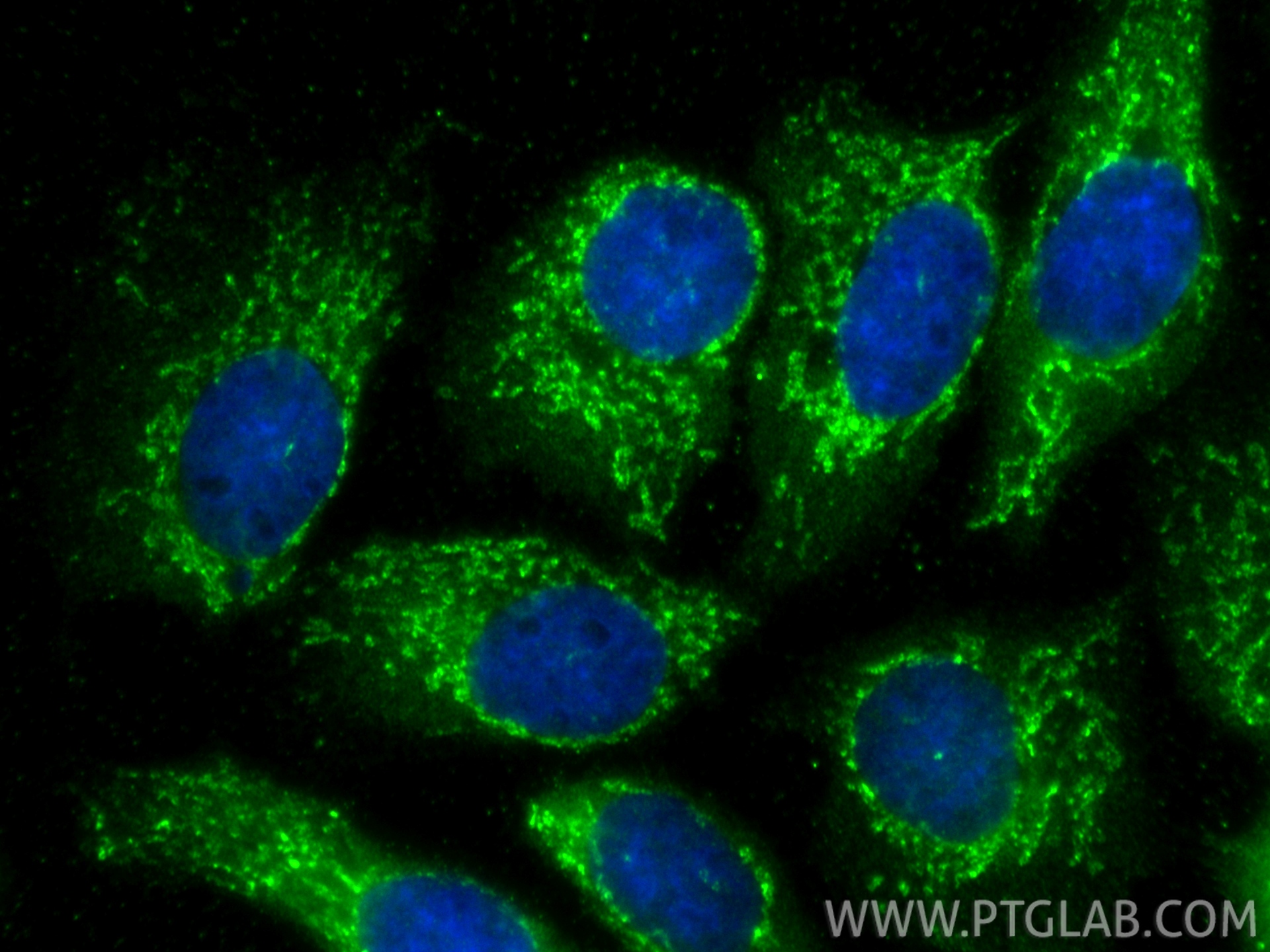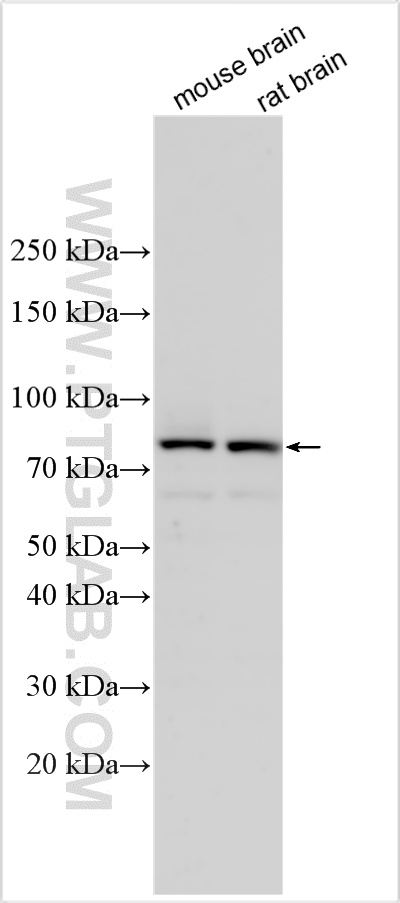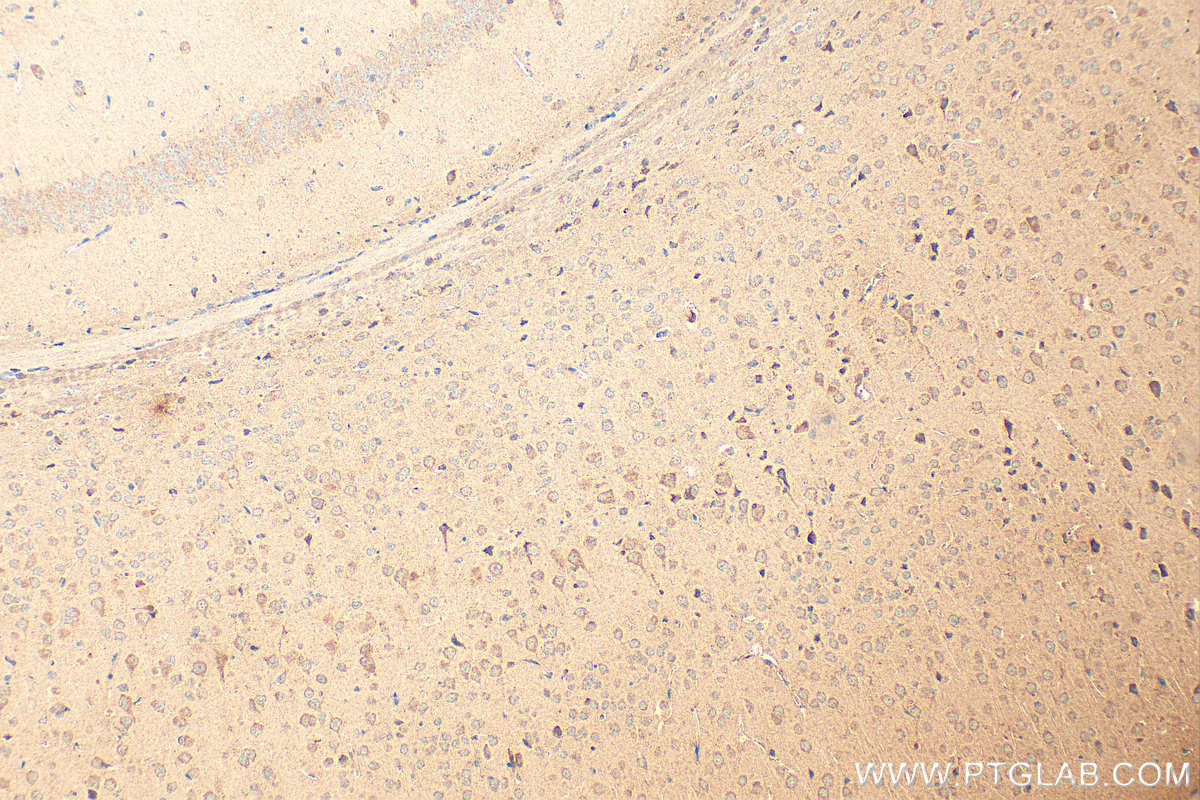验证数据展示
经过测试的应用
| Positive WB detected in | HEK-293T cells, HeLa cells, mouse brain tissue, HepG2 cells, MCF-7 cells, rat brain tissue |
| Positive IP detected in | mouse brain tissue |
| Positive IHC detected in | mouse brain tissue Note: suggested antigen retrieval with TE buffer pH 9.0; (*) Alternatively, antigen retrieval may be performed with citrate buffer pH 6.0 |
| Positive IF/ICC detected in | A431 cells |
推荐稀释比
| 应用 | 推荐稀释比 |
|---|---|
| Western Blot (WB) | WB : 1:2000-1:16000 |
| Immunoprecipitation (IP) | IP : 0.5-4.0 ug for 1.0-3.0 mg of total protein lysate |
| Immunohistochemistry (IHC) | IHC : 1:300-1:1200 |
| Immunofluorescence (IF)/ICC | IF/ICC : 1:200-1:800 |
| It is recommended that this reagent should be titrated in each testing system to obtain optimal results. | |
| Sample-dependent, Check data in validation data gallery. | |
产品信息
17719-1-AP targets P5CS in WB, IHC, IF/ICC, IP, CoIP, ELISA applications and shows reactivity with human, mouse, rat samples.
| 经测试应用 | WB, IHC, IF/ICC, IP, ELISA Application Description |
| 文献引用应用 | WB, IHC, IF, CoIP |
| 经测试反应性 | human, mouse, rat |
| 文献引用反应性 | human, mouse, rat |
| 免疫原 |
CatNo: Ag12100 Product name: Recombinant human ALDH18A1 protein Source: e coli.-derived, PET28a Tag: 6*His Domain: 1-362 aa of BC106054 Sequence: MLSQVYRCGFQPFNQHLLPWVKCTTVFRSHCIQPSVIRHVRSWSNIPFITVPLSRTHGKSFAHRSELKHAKRIVVKLGSAVVTRGDECGLALGRLASIVEQVSVLQNQGREMMLVTSGAVAFGKQRLRHEILLSQSVRQALHSGQNQLKEMAIPVLEARACAAAGQSGLMALYEAMFTQYSICAAQILVTNLDFHDEQKRRNLNGTLHELLRMNIVPIVNTNDAVVPPAEPNSDLQGVNVISVKDNDSLAARLAVEMKTDLLIVLSDVEGLFDSPPGSDDAKLIDIFYPGDQQSVTFGIKSRVGMGGMEAKVKAALWALQGGTSVVIANGTHPKVSGHVITDIVEGKKVGTFFSEVKPAGPT 种属同源性预测 |
| 宿主/亚型 | Rabbit / IgG |
| 抗体类别 | Polyclonal |
| 产品类型 | Antibody |
| 全称 | aldehyde dehydrogenase 18 family, member A1 |
| 别名 | ALDH18A1, Aldehyde dehydrogenase family 18 member A1, Delta-1-pyrroline-5-carboxylate synthase, Gamma-glutamyl kinase, Gamma-glutamyl phosphate reductase |
| 计算分子量 | 795 aa, 87 kDa |
| 观测分子量 | 87 kDa |
| GenBank蛋白编号 | BC106054 |
| 基因名称 | P5CS |
| Gene ID (NCBI) | 5832 |
| RRID | AB_2223896 |
| 偶联类型 | Unconjugated |
| 形式 | Liquid |
| 纯化方式 | Antigen affinity purification |
| UNIPROT ID | P54886 |
| 储存缓冲液 | PBS with 0.02% sodium azide and 50% glycerol, pH 7.3. |
| 储存条件 | Store at -20°C. Stable for one year after shipment. Aliquoting is unnecessary for -20oC storage. |
背景介绍
Delta 1-pyrroline-5-carboxylate synthetase (P5CS), also named as GSAS and PYCS, catalyzes the ATP and the NAD(P)H-dependent conversion of L-glutamate to glutamic gamma-semialdehyde (GSA) which is the metabolic precursor for proline biosynthesis(PMID:8761662). This protein includes 2 domains: glutamate 5-kinase and gamma-glutamyl phosphate reductase. In the N-terminal section, it belongs to the glutamate 5-kinase family and in the C-terminal section, it belongs to the gamma-glutamyl phosphate reductase family. Defects in ALDH18A1 are the cause of cutis laxa, autosomal recessive, type 3A (ARCL3A)(PMID:18478038). It has 2 isoforms produced by alternative splicing.
实验方案
| Product Specific Protocols | |
|---|---|
| IF protocol for P5CS antibody 17719-1-AP | Download protocol |
| IHC protocol for P5CS antibody 17719-1-AP | Download protocol |
| IP protocol for P5CS antibody 17719-1-AP | Download protocol |
| WB protocol for P5CS antibody 17719-1-AP | Download protocol |
| Standard Protocols | |
|---|---|
| Click here to view our Standard Protocols |
发表文章
| Species | Application | Title |
|---|---|---|
Nature Cellular ATP demand creates metabolically distinct subpopulations of mitochondria
| ||
J Exp Med Inhibiting both proline biosynthesis and lipogenesis synergistically suppresses tumor growth.
| ||
Autophagy Autophagy loss impedes cancer-associated fibroblast activation via downregulating proline biosynthesis. | ||
Proc Natl Acad Sci U S A Reprogramming of proline and glutamine metabolism contributes to the proliferative and metabolic responses regulated by oncogenic transcription factor c-MYC. | ||
Int J Biol Macromol Role of GATM/creatine as energy reserves in the poll gland and rutting activities in male Bactrian camel |








